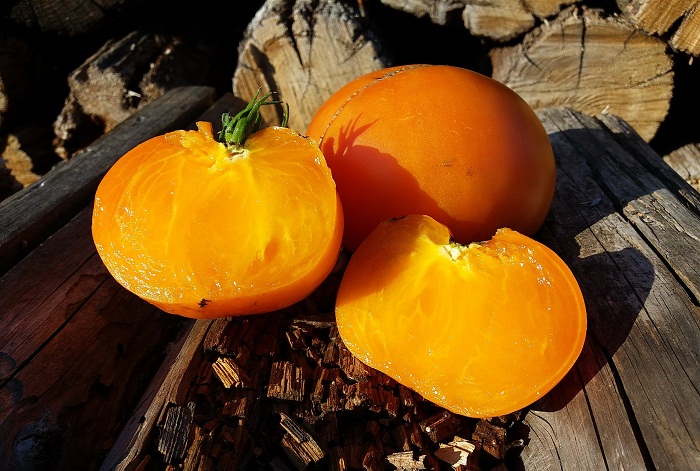 Many summer residents, saturated with the tastes of domestic tomatoes, try to acquire more rare and exotic varieties of this vegetable. These include the old family-owned American variety, Doctor Doctor. In his homeland, he proved himself only on the best side: he brings huge half-kilogram fruits, almost never gets sick and grows well in cool environmental conditions.
Many summer residents, saturated with the tastes of domestic tomatoes, try to acquire more rare and exotic varieties of this vegetable. These include the old family-owned American variety, Doctor Doctor. In his homeland, he proved himself only on the best side: he brings huge half-kilogram fruits, almost never gets sick and grows well in cool environmental conditions.
In our country, these indicators are no worse.
Content
Grade characteristics
American tomato Dr. Wyche (Dr Wyche’s) is a rare variety for our country. The variety is characterized by strong bush growth: the plant height reaches 180-200 centimeters. Indent has a rare simple form of dark green foliage. Decorated with dozens of brushes hung with huge fleshy fruits. Be sure to form a bush of 2-3 stems and a garter to a reliable support.
Dr. HIV is recommended for cultivation in greenhouse conditions. Fruit ripening occurs 110 days after the appearance of the first seedlings.
Fruits have a flat-round oblate non-uniform shape. Very heavy - up to 500 grams in weight. The peel is smooth, shiny, painted in a bright orange color. The pulp is friable, oily, very sweet due to its high sugar content. Seeds are few.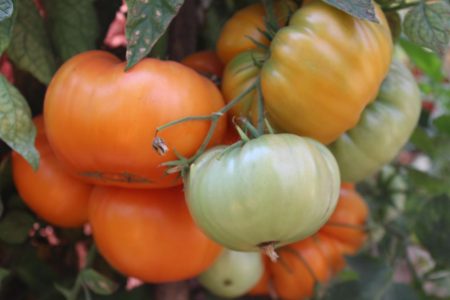
The variety is characterized by high productivity. From this bush you can collect up to 12 kilograms of delicious high-quality tomatoes. Fresh tomatoes are good for eating, and also go well for juices and tomatoes.
Grade Benefits
- huge fruits;
- a lot of carotene content;
- long fruiting period;
- rare, elite variety;
- high yielding.
Minuses
- the fruits are not stored for long;
- require constant garter and strong support, as the severity is very massive.
Growing Features
Growing a tomato of this variety is no different from other varieties. Seeds are sown in March, so that by the time the seedlings are planted in a permanent place, the bushes are about 55-60 days. Soil mix for seedlings should consist of garden soil, humus and peat. Superphosphate, potassium sulfate and urea are also added to this composition.
Dr Vich is sown in seedlings or immediately in separate peat cups. In the phase of one or two leaves, seedlings are planted in separate containers (dive). From this moment begins the intensive growth of seedlings. Bushes stretch up a couple of centimeters per day. At the time of planting seedlings in the soil, the height of the plants will reach 30-40 centimeters.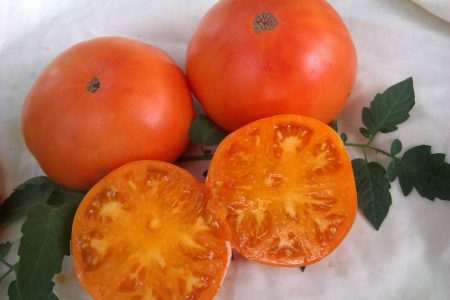
During the seedling period, you need to make regular dressing. For the first time, seedlings feed after a dive. For starters, you can add organic matter (humus mixed with water). Then, after 10 days, the bushes are fed a second time with a mixture of urea, superphosphate, potassium sulfate and water.
Landing
By the time the seedlings are planted in the greenhouse, up to 10 true leaves and at least one flower brush will appear on each bush. The street will be the beginning of May.
The land for tomatoes is prepared in advance, preferably in the fall. Under digging add humus, peat or compost. In the spring, you also need to dig the soil and level it, and then close up the ridges.
Tall tomatoes need a lot of fertilizer to nourish a powerful and branched plant two meters tall.Therefore, even before planting tomatoes, nitrogenous fertilizers should be added, as well as minerals such as potassium and phosphorus. If the soil is too dense, then river sand can be introduced, so the earth will become more porous.
Indients need to be planted correctly so that subsequently the bushes do not obscure each other and are well ventilated. Therefore, you need to leave about 40-50 centimeters between the holes. And on the aisle to allocate 60-70 centimeters of land.
Care
Of course, it is much more difficult to care for an indent than, for example, a medium-tall tomato. Large vegetative mass, abundant harvest - all this requires intensive caring measures. However, it is worth trying to eventually get an excellent crop of rare tomatoes in our country with such intelligent roots as Doctor Vich.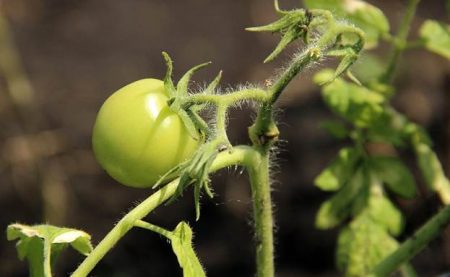
Growing Dr. HIV in a greenhouse is the best option. It takes up little space, grows more healthy, and brings many times more fruits. In addition, tall bushes of the variety stretch up, and then under the bushes it is always dry, the leaves do not lie on the ground, which means that the risk of fungal diseases is zero. Yes, and rodents, and insect pests also can not get tidbits, since they are high above the ground.
Watering
Watering the bushes is necessary only under the root, so that the leaves and stems of the plants remain dry. Water should be warm and better settled.
For Dr. HIV, regular watering is important. The less often water will flow to the roots, the smaller the fruits will be, and during ripening they will crack. To maintain water balance, it is better to mulch the beds. Mulch from straw or withered grass will retain moisture in the earth for longer, and will not let the roots get too warm.
If during a transplant the plant was taken out of the seedling container, then most likely the rhizome could be damaged, and therefore frequent, moderate watering is especially important for such plants in order to be quickly rehabilitated under new conditions. If the roots were not touched during transportation, then one after-planting irrigation for several days is enough.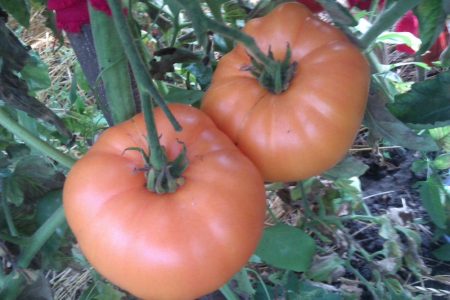
AT
The older the plants, the more water they need. Especially you need to pay attention to watering during flowering and ripening of fruits.
Formation
Dr. Witch must be formed, otherwise the bushes will grow into one continuous shrub and yield will drop. For this variety, formation in two or three stems is suitable. To do this, remove all stepsons, leaving only the two lower ones located above the top sheet. They will grow, playing the role of stems.
Please note: many beginner gardeners often make a mistake when they leave all the flowers, thinking that there will be more fruits. However, the more tomatoes ripen, the smaller they will be. Therefore, when growing an indent, think that your priority is size or quantity.
In August, plant formation usually stops. And so that all the energy spent on the ripening of the fruit, it is better to pinch the top, thereby stopping the growth of the bush.
Garter
Dr. Vich needs constant garter and additional support structures, because the stems break off rather quickly due to the severity of the branches on which 400-500 gram tomatoes are formed.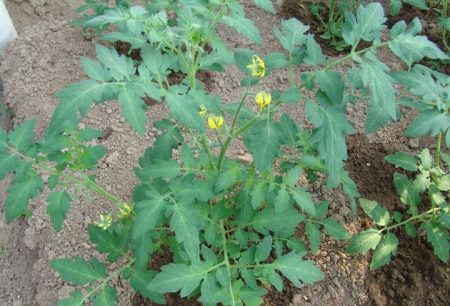
If a trellis will be used, it is better to plant the bushes closer to the edge of the ridge, and the transverse support is installed in the center. A strong thread is stretched between the stakes at a distance of 30 centimeters from the ground. With the growth of the plant, you need to stretch a new layer, etc.
Top dressing
Like all other varieties, Dr. HIV tomatoes are fed at least three times per season. Organic fertilizers (mullein, chicken droppings) and mineral fertilizers should be regularly used as fertilizers.
The first top dressing is carried out a couple of weeks after the seedlings are planted on the bed, at the moment when the first brush blooms. Superphosphate is added to the organics.
During the ovary of the first fruits, a second recharge is carried out with the same composition.
Plants are also fed for the third time - during the period of the first harvest (increasing the concentration of fertilizers).
If the bushes grow well, but do not bloom well, this means that the plants receive too much nitrogen, so it should be abandoned, giving preference to phosphorus compounds.
Reviews
Mark
First planted them last season and really loved them. I also planted three more rare species with them. Dr. HIV tomatoes have grown the most prolific, large. They ripened in July. The fruits appeared together, the ovaries, by the way, were formed on a very large scale, the whole bush blossomed very beautifully. Fruited tomatoes right up to the frost. The fruits are very tasty, just huge, sweet. The only minus for me was bad keeping quality: they quickly sour, so you need to eat them right away, without delay.
Galina
I tried to plant this variety. I didn’t really like it. I do not like irregularly shaped tomatoes. They all turned out to be not evenly smooth, some kind of ribbed surface. And the quality of the tomatoes is quite decent. They collected a lot from the bush: on each brush pieces of 15 tomatoes were formed - the sight, of course, was beautiful.
Lyudmila
My daughter lives in America. They have been growing this variety there for many years. These tomatoes are in great demand in the USA, as this is still a classic of the genre for them. So they always have excellent harvests of the variety Dr. Vich. The daughter always mulches the beds with tomato straw or wood chips, so they rarely water the ground. The taste is really gorgeous, I tried. Very juicy, crumbly. They go great for sauces, lecho and soups. But in the cut they look, however, not very aesthetically pleasing.




 Low-growing tomatoes, without pinching: 5 of the most delicious varieties
Low-growing tomatoes, without pinching: 5 of the most delicious varieties Why tomato seedlings grow poorly
Why tomato seedlings grow poorly We grow a tomato in a shell
We grow a tomato in a shell Growing tomatoes without watering according to the method of Kazarin
Growing tomatoes without watering according to the method of Kazarin